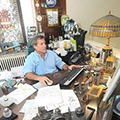 Robert D’Alessandri spent 30 years at West Virginia University, where he established a new medical school and built clinical campuses in adding to his reputation as a national leader in healthcare policy. A specialist in infectious diseases and general medicine, D’Alessandri has brought high expectations to The Commonwealth Medical College, which lured him to Scranton to lead the state’s first new medical school in 40 years. The school, which welcomed its inaugural class last month, has already applied for a patent and is way ahead of schedule in discussions for a licensing agreement.
Robert D’Alessandri spent 30 years at West Virginia University, where he established a new medical school and built clinical campuses in adding to his reputation as a national leader in healthcare policy. A specialist in infectious diseases and general medicine, D’Alessandri has brought high expectations to The Commonwealth Medical College, which lured him to Scranton to lead the state’s first new medical school in 40 years. The school, which welcomed its inaugural class last month, has already applied for a patent and is way ahead of schedule in discussions for a licensing agreement.
Keystone Edge: What was the first day with students on campus like?
Robert D’Alessandri: It was a Sunday morning at 10 a.m. when we had the beginning of orientation. Some board members showed up, too. We had news media here, and 10 o’clock on a Sunday morning isn’t a usual time to see media, especially since it wasn’t a scheduled media event, but they did extensive stories. We’ve had letters, people sending flowers, sending fruit, all kinds of things over the last few days. It’s been a tremendous outpouring of support. One of the comments I hear repeatedly was “I didn’t believe this could happen.” But they’re delighted and they realize how important it is to the area.
KE: Sounds like the school has made quite a splash in Scranton.
RD: We are feeling a little bit like celebrities in town. We also know there’s a tremendous amount of work that needs to be done in terms of teaching these students. We know how far off graduation is–guess who’s counting. There are still lots of hurdles, but we have a very dedicated staff that is very committed and we have the talent to make this work. We’re feeling very good at this point.
KE: Describe your role in the development of the school.
RD: The entire thing is under my watch, including putting together the team that would make this a reality. I went around the country and looked for the very best people. For example, we found Dr. (Paul) Katz to fill the role of vice dean, and he had 35 years of experience in academic medicine. We did not bring in people who didn’t have experience. That was the only way we could get it done in such a short period of time. I’m also responsible for fund-raising and do a lot of public relations for the institution, and generally provide guidance.
We had a set a deadline of June 1 to complete a list of about 1,000 different things. We went through some mock experiences to make sure we had it all down. By mid-July we were feeling really good about where we were.
KE: So what do you do to welcome 65 new students to a new medical school?
RD: One of the things that’s so important in medical education is the point that learning is a team effort. Students learn best in groups. It helps support them, provides a little comfort when things get tight. One of the things we’ve done is several icebreakers with the students. We had them form little groups for orientation and do their own take of the Food Network’s chef competition. We had them form teams according to their clinical campus group (Wilkes-Barre, Williamsport or Scranton) and make a cake that had to tell the story of what they expect to get out of their medical education. They did a wonderful job.
KE: How would you describe your inaugural class of students?
RD: One of the things that surprised us is we knew we had a great class of students, but they’re even better than we thought. They’ve been outstanding, so responsive and so committed. We all feel our admissions committee did an excellent job. Seventy-five percent of our students come from Pennsylvania, and that’s the largest percentage of any school in the state. That was done intentionally.
KE: You’ll be using buildings at Lackawanna College until your own campus is ready by the summer of 2011. What are the temporary facilities like?
RD: The facilities are really outstanding. Our anatomy lab is comparable to any in the country. It’s state-of-the-art. Our classrooms are all wired with up-to-date equipment and our simulation lab has several hundred thousand dollars worth of equipment. What’s the difference between this facility and the new facility? One is the size of the rooms, they’ll be larger at the new facility. Our equipment and technology will be mostly the same, we’re going to move it. Our students will not be disadvantaged at all. They’ll have the most modern learning technology.
Joe Petrucci is the managing editor of Keystone Edge. Send feedback here.
To receive Keystone Edge free every week, click here.

